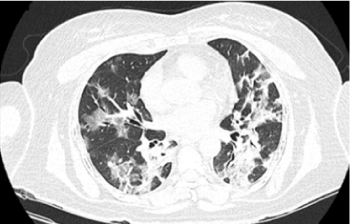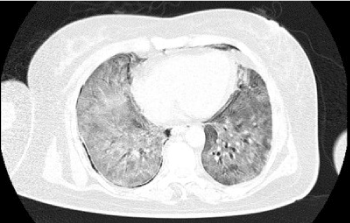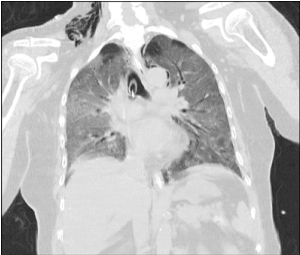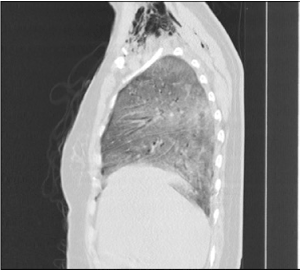In the context of the COVID 19 pandemic, chlorine dioxide treatment has been promoted as a treatment, however health authorities in several countries including Mexico have warned of serious adverse reactions that put the lives of people at risk. they consume it. We report the case of a patient with COVID 19 infection who presents with respiratory failure secondary to oral and intravenous use of chlorine dioxide, requiring intubation, with multiple organ failure and ended with the death of the patient 5 days later.
COVID 19, chlorine dioxide, poisoning
The FDA, The Pan American Health Organization (PAHO), Health Authorities of several countries joined efforts to prevent the use of products based on Chlorine Dioxide, Sodium Chlorite or their derivatives, as well as the presentation called "Miracle Mineral Solution (SMM, MMS or CDS)”, which are marketed irresponsibly for the prevention and treatment of various diseases, including cancer and COVID-19, these products can be found for sale illegally on the internet and in some establishments of medical attention and whose main use is as an industrial disinfectant. On July 23 in Mexico, COFEPRIS launches a statement warning of adverse health effects after the use of this product. So far there have been no known cases in Mexico of adverse health effects after consumption and intravenous administration of chlorine dioxide,
Chlorine dioxide is a strong oxidizing agent that reduces to chlorite under oxidative stress. The strong oxidizing property makes it a very useful agent in water disinfection, textile bleaching, antimicrobial applications, reducing absorbable halogenated organic compound loads in effluent industries. Chlorine dioxide rapidly dissociates into chlorite. and chloride, and to a lesser degree in chlorate [1,2].
Chlorine dioxide and sodium chlorite react rapidly in human tissues and, if ingested, can cause irritation of the mouth, esophagus and stomach, with a severe irritative digestive picture, with the presence of nausea, vomiting and diarrhea, in addition of serious hematological disorders (methemoglobinemia, hemolysis, etc.), cardiovascular and kidney. The decrease in blood pressure can lead to serious symptoms such as respiratory complications due to the modification of the blood's ability to transport O2. Additionally, inhalation through nebulizers can cause pulmonary edema, bronchospasm, chemical pneumonitis and glottis edema, and even cause death if exposures are above the occupational exposure limit value. Long-term exposure can lead to chronic bronchitis and dental erosions.
Websites that sell chlorine dioxide products generally describe the product as a liquid that contains 28% sodium chlorite in distilled water. Product instructions instruct consumers to mix sodium chlorite solution with citric acid, such as lemon or lime juice, or another acid, such as hydrochloric acid, before drinking. In many cases, sodium chlorite is sold as part of a kit with a citric acid "activator". When the acid is added, the mixture turns into chlorine dioxide, a powerful bleaching agent that has caused serious and life-threatening side effects [3-5].
58-year-old female, hypertensive for 15 years, began a current condition approximately 14 days ago with general symptoms, asthenia, adynamia, non-productive cough, quantified thermal rises up to 39 degrees, for which she goes to a private physician who begins treatment for oseltamivir base + dexamethasone + azithromycin + ceftriaxone + enoxoparin + colchicine without referring specified time. RT PCR was performed for SARS COV2 on August 18, 2020, which was reported positive, as well as a private chest tomography with ground-glass image suggestive of atypical pneumonia with severe CORADS 5 disease (Figure 1), so continued treatment. On August 20, 2020, she presented dyspnea on exertion, which was exacerbating, for which she went to the emergency room of the General Hospital of Boca del Rio, Mexico where she received unspecified in-hospital treatment requesting voluntary discharge one day after hospitalization [4,5]. Maintaining established treatment at home and oxygen saturation greater than 90% to be referred by relatives. On August 24, 2020, due to persistence of dyspnea and hypoxemia despite the use of supplemental oxygen at home, he decided to manage with complementary therapy of the type of carbon dioxide ingested orally and intravenously (it is unknown who administered the drug and under indication of which personnel of health) refers to oral intake of 1000 ml of chlorine dioxide solution plus intravenous administration of 500 ml of 0.9% saline solution with 28% sodium chlorite, presenting sudden respiratory deterioration, decreasing oxygen saturation up to 60% [5-8]. She was transferred to the emergency room where hypertensive uncontrol was documented with TA 183/88, tachypnea with 38 bpm, tachycardia of 121 bpm, with SatO2 of 60%, being intubated on the second attempt by means of direct video laryngoscopy initiating invasive mechanical ventilation after sedation, her SOFA of Admission was 13 points, APACHE II 26 points, NEWS 2 11 points, with blood gas reporting PH 7.28, PCO2 58, PO2 136, HCO3 24.4, FIO2 100. Within the physical examination, excoriations at the level of the lips, diffuse bilateral rales, with dullness to percussion, hippocratic fingers, the patient developed within the first hours fluid-refractory hypotension for which norepinephrine was started. anticoagulation, broad spectrum antibiotic, steroid with hydrocortisone 50 mg IV every 6 hours, as well as data of acute liver failure with elevation in total bilirubin, and transaminases and DHL, with marked leukocytosis, a chest tomography was performed after ingestion of carbon dioxide [8,9]. chlorine reporting diffuse bilateral alveolar pattern (Figure 2) suspecting secondary aspiration pneumonitis, likewise airway injury generating pneumomediastinum (Figures 3 and 4), there was an increase in fluid intake, however the patient presented acute kidney injury AKIN III, renal replacement therapy was requested, however due to the severity of the patient, was reported no candidate (Table 1). Death presented 5 days after the ingestion of chlorine dioxide.

Figure 1. Bilateral ground glass image with severe affection and mixed lesions (7 days prior to ingestion)

Figure 2. Tomography of the chest after ingestion of chlorine dioxide with images with a bilateral diffuse alveolar pattern

Figure 3. Chest tomography with the presence of air in the right supraclavicular area with increased density diffused throughout the lung parenchyma

Figure 4. Chest tomography with the presence of air in the right supraclavicular area with increased density diffused throughout the lung parenchyma
Table 1. Biochemical evolution of patient
|
(24.08.20) |
(25.08.20) |
(27.08.20) |
(28.08.20) |
Hb / leucocytes |
15.8 / 17,990 |
13.6 / 20,100 |
12.7 / 18.78 |
12.1 / 27,480 |
Platelets |
2,80,000 |
2,34,000 |
2,61,000 |
2,80,000 |
Glucose |
215 |
149 |
105 |
215 |
Urea / Creatinine |
24.28 / 0.5 |
51.4 / 1.3 |
105 / 3.1 |
199 / 6.1 |
Na+ / K+ |
136 / 4.8 |
141 / 4.5 |
145 / 6.1 |
142 / 6.6 |
BT / BD |
2.65 / 1.42 |
1.66 / 1.6 |
1.6 / 1.5 |
1.5/ 1.4 |
AST / ALT |
131 / 122 |
112 / 102 |
80 / 74 |
58 / 47 |
DHL |
1441 |
1064 |
942 |
827 |
D dimer |
2023 |
|
|
5974 |
BNP |
30.7 |
156 |
|
264 |
Arterial blood gas |
pH 7.28 |
pH 7.06 |
pH 7.22 |
pH 7.22 |
pCO2 58 |
pCO2 112 |
pCO2 58 |
pCO2 58 |
pO2 136 |
pO2 88 |
pO2 31 |
pO2 31 |
Hco3- 24.4 |
Hco3- 20.9 |
Hco3- 23.7 |
Hco3- 23.7 |
BE 0.6 |
BE -4.7 |
BE- 4.7 |
BE- 4.7 |
FiO2 99% |
SO2 88% |
RI 11.6 |
RI 11.6 |
|
A-aDO2 271 |
PaO2/PAO2 391 |
PaO2/PAO2 391 mmHg |
|
PaFi 110 |
Fio2 65%. |
FiO2 65%. |
|
FiO2 70 |
|
|
SOFA |
13 points (50-60% mortality) |
APACHE II |
26 points (55% mortality) |
- NewsCAP (2019) The FDA warns consumers not to drink miracle mineral solution and other sodium chlorite products. Am J Nurs 119:14.
- Taylor J, Wohlers D, Amata R (2004) Toxicological profile for chlorine dioxide and chlorite.
- Lin JL, Lim PS (1993) Acute sodium chlorite poisoning associated with renal failure. Ren Fail 15: 645-648. [Crossref]
- Andrea R, Luigina C, Alessandro D, Oliviero F, Carlotta F, et al. (2006) A case of acute sodium chlorate self-poisoning successfully treated without conventional therapy. Nephrol Dial Transplant 21:2971-2974. [Crossref]
- Kishan H (2009) Chlorine dioxide-induced acute hemolysis. J Med Toxicol 5:177. [Crossref]
- Zhao M, Wang Y (2005) One case of myocardial damage due to chlorine dioxide poisoning. Bing Za Zhi 23: 470. [Crossref]
- Nicolás FD, Mesonero R, Molero V, Nieto M, Herreros C, et al. (2016) Irritant contact dermatitis from “miracle mineral solution”: 2757. J Am Acad Derm 74: 5.
- Brocker KA, Nehls K, Sohn C, Eichbaum M (2011) Massive vaginal epitheliolysis after treatment of lsil and human papilloma virus with chlorine dioxide. Geburtshilfe und Frauenheilkunde 71: 521-524.
- Arnold J, Rushton W (2018) The mineral miracle disaster: accidental poisoning after use of 28% sodium chlorite solution resulting in methemoglobinemia and mild hemolytic anemia. Clin Toxicol 56: 941-942.




